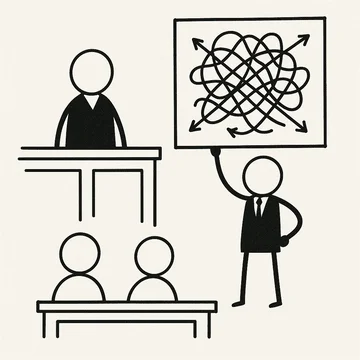
At this point, all of the D. Del. judges have adopted a joint claim construction brief procedure invented by Judge Andrews, where the parties serve opening, answering, reply, and surreply briefs, and then file a single combined joint claim construction brief that presents the arguments term-by-term. This means that the parties and the Court can work from a final, combined joint brief where all of the arguments match up.
This is a great procedure and everyone seems to like it. Certain questions tend to come up about it, though.
Common Questions on the Joint Claim Construction Brief
First, parties sometimes squabble over whether the briefs can include introductions and counter-introductions, or tech tutorials and counter-tutorials (and so on). I'm not sure any judge has ruled on this, but most times the parties end up agreeing that such additional material is OK as long as it is presented in back-and-forth order in the combined brief.
I would consider whether you really want a series of general introductions, though—sometimes they can look a bit silly (or meaningless) when lined up in back-and-forth fashion in the final joint brief.
Second, parties sometimes get tripped up on how to deal with internal citations to the other parties' materials. Normally the way this works is that the parties exchange Word versions of the briefs, and local counsel for plaintiff handles combining the as-served briefs and circulates it to the other side. The other side (defendant(s)) then updates their citations. Sometimes it takes a couple of rounds of this, as the pagination can change as parties update their cites (that is solvable to some extent by citing section numbers instead of specific pages).
Finally, defendants often seem surprised when a plaintiff offers new material in its "reply" brief, arguing that it constitutes sandbagging (improperly withholding material for a reply that should have been included in a full and fair opening brief).
One common circumstance is that a plaintiff will serve an opening claim construction brief, and then the defendant will include an expert declaration in its answering claim construction brief brief. The plaintiff will then include a responsive expert declaration with their reply brief, prompting allegations of sandbagging ("why wasn't the declaration in the opening?!").
In my view, however, it's fine to offer a responsive declaration for the first time in an reply claim construction brief, as long as the declaration responds to a declaration offered in the answering brief. The "reply" brief is functionally more of a combined reply brief and answering brief, and the defendant gets a surreply brief by default. Under those circumstances, there is no reason plaintiff shouldn't be permitted to include responsive arguments to new issues in its reply.
Judge Williams Clarifies "Sandbagging" in Joint Claim Construction Briefing
The Court issued an order more or less consistent with that position yesterday, declining to strike new material offered for the first time in a reply claim construction brief because it responds to material in the answering brief:
ORAL ORDER: The Court, having reviewed Defendant's motion to strike portions of a 110-page declaration submitted by Plaintiff's technical expert, Dieter Hotz (the "Motion"), . . . and the briefing related thereto, . . . HEREBY ORDERS that the Motion is DENIED. Defendant argues that portions of the declaration, which was submitted along with Plaintiff's claim construction reply brief, should be stricken because its service violates D. Del. LR 7.1.3(c)(2) ("The party filing the opening brief shall not reserve material for the reply brief which should have been included in a full and fair opening brief."). Plaintiff argues that (1) "the Hotz Declaration was appropriately responsive to Uber's arguments in its answering claim construction brief" and (2) the declaration does not violate D. Del. LR 7.1.3(c)(2) because Defendant has a sur-reply available to it and thus has a "full and fair opportunity to respond." D.I. 91 at 2 (quoting Wilmot v. Marriott Hurghada Mgmt., Inc., 712 F. App'x 200, 204 n.2 (3d Cir. 2017)). Plaintiff explains in their briefing how the paragraphs Defendant seeks to strike are responsive to Defendant's claim construction answering brief, (D.I. 91 at 3-5), noting that the declaration addresses indefiniteness arguments that Plaintiff could not properly respond to prior to receiving Defendant's briefing, arguments relating to specific portions of the structure not previously identified before the answering brief, and arguments combatting Defendant's statements on how a person of ordinary skill in the art would understand the meaning of the claims. . . . It is understandable why Plaintiff could not address these points in their opening brief with the declaration. . . . Thus, the submission of the declaration is not untimely.
SurgeTech, LLC v. Uber Technologies Inc., C.A. No. 22-882-GBW (D. Del. Jun. 13, 2023).
The Court also noted that any prejudice is cured by the fact that defendant gets a surreply brief:
Furthermore, any prejudice against the Plaintiff is cured by permitting a sur-reply and holding a claim construction hearing wherein both parties will be heard. Id.; see also Fifth Mkt., Inc. v. CME Grp., Inc., C.A. No. 08-520-GMS, 2013 WL 3063461, at *1 n.2 (D. Del. June 19, 2013) ("[D. Del. LR 7.1.3(c)(2)] exists, in part, to prevent litigants from engaging in impermissible 'sandbagging,' reserving crucial arguments for a reply brief to which an opponent cannot respond." . . . . Additionally, Defendant will receive an extra 1,000 words for its sur-reply, (DI. 91 at 5), and this Court has extended Defendant's sur-reply claim construction brief deadline to two weeks from the date of this Order. D.I. 90.
That last part—the extra 1000 words—was volunteered by plaintiff. I imagine the Court would likely have reached the same result even absent the word limit extension, although you never know.
If you enjoyed this post, consider subscribing to receive free e-mail updates about new posts.






